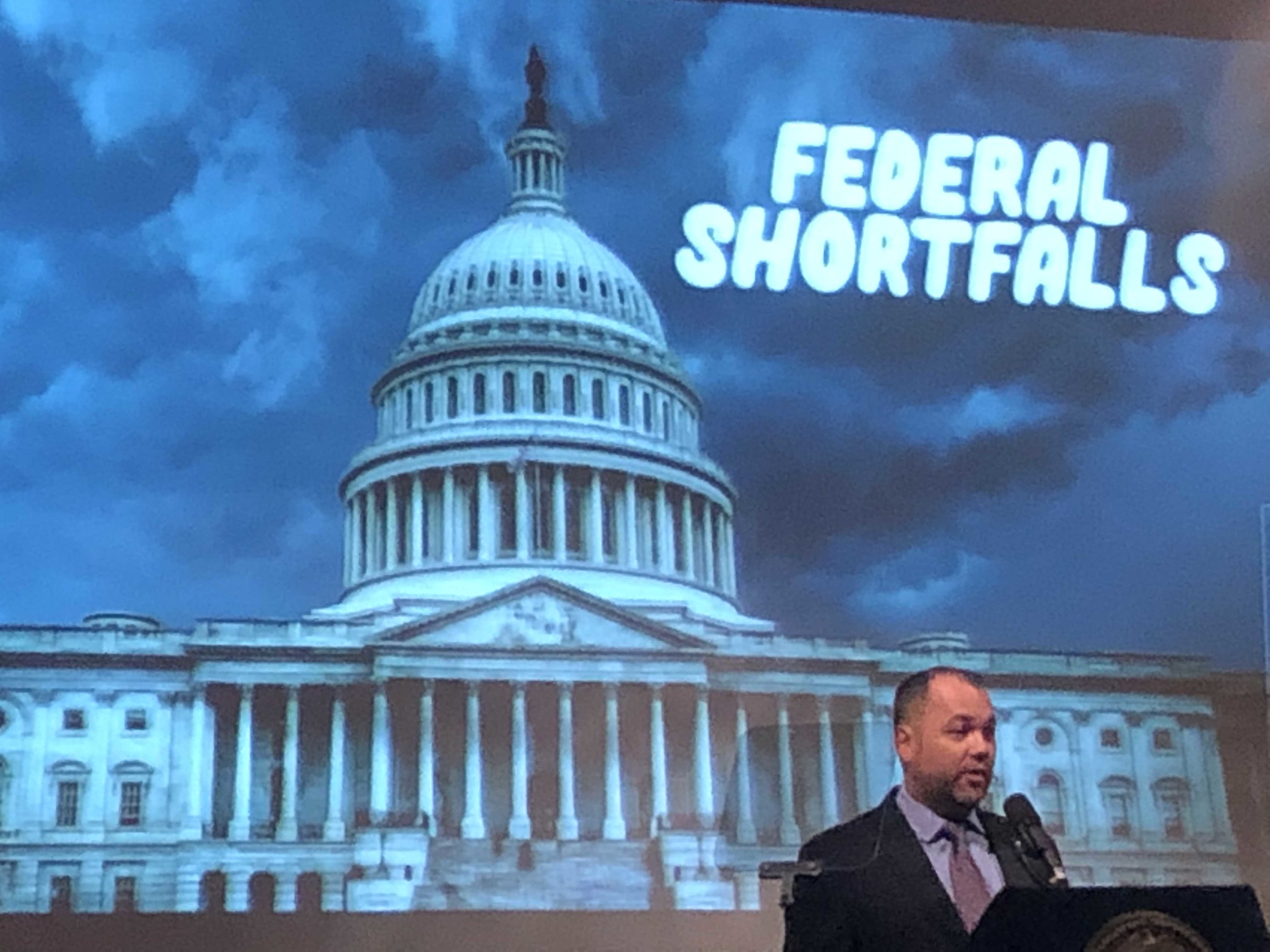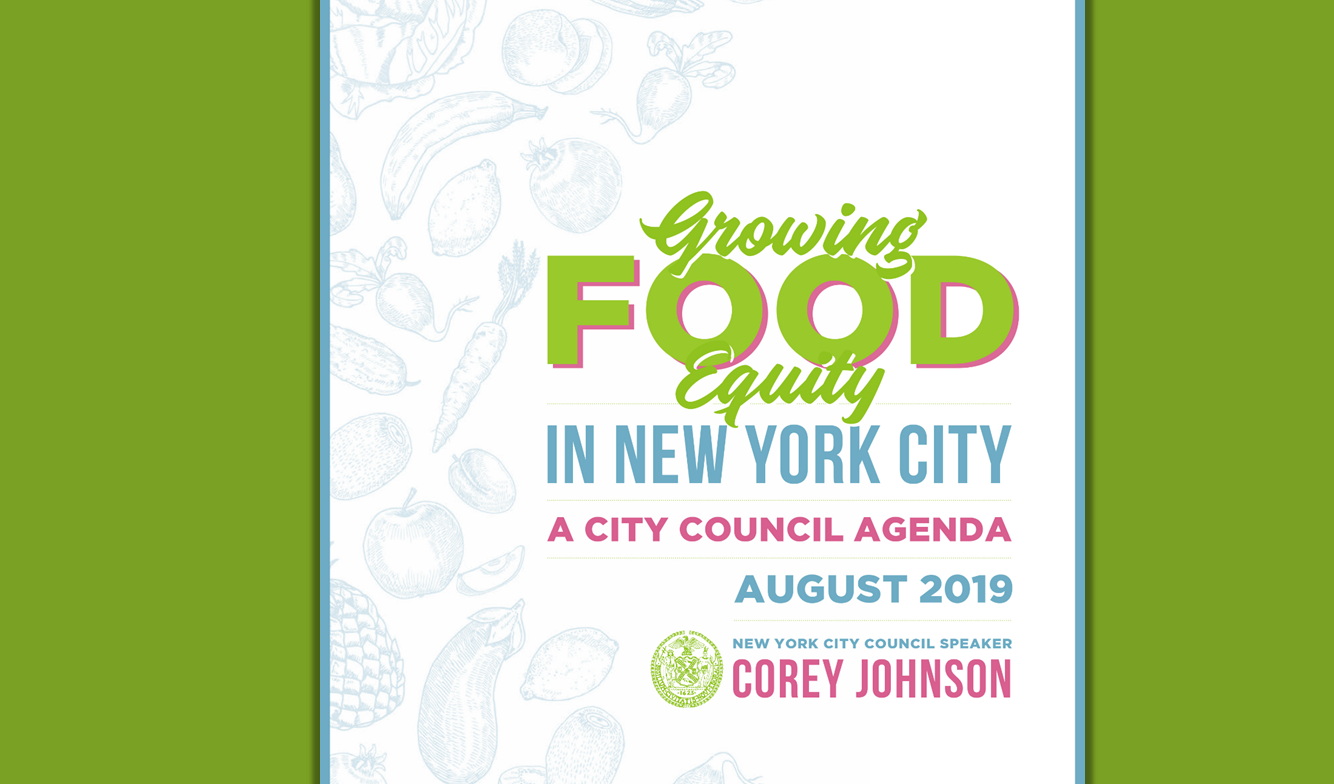On August 1st, New York City Council Speaker Corey Johnson presented his plan to address food inequities in New York City, defined as unequal access to healthy food and socioeconomic, racial/ethnic and other disparities in the impact of the food system on well-being.
The report outlines the food-related problems the city faces including high levels of food insecurity, lack of access to healthy and affordable food for New Yorkers in low-income communities and communities of color, and food waste.
The Speaker’s plan proposes several major new bills and policies for consideration by the City Council to codify and strengthen the Mayor’s Office of Food Policy; to require the city to create a multi-year citywide food plan as well as a stand-alone urban agriculture plan; and to expand the annual New York City Food Metrics report to include reporting requirements for city food initiatives that are not currently documented. The Speaker’s Growing Food Equity report makes dozens of other recommendations in such areas as food governance, hunger, food waste, and school food.

At the press conference releasing the report Speaker Johnson observed:
“New York City is one of the richest cities in the world. Yet more than one million of our residents are considered food insecure. That’s unacceptable. Food is a human right, which means as a city we need to establish food policies to help ensure that none of our residents are going hungry or relying on unhealthy foods to survive because they don’t have the means or access to nutritious meals. These proposals are my vision for food justice for New York City. I want to create a better New York where equitable food policies are front and center in everything we do.”
The CUNY Urban Food Policy Institute welcomes this report and looks forward to working with the Speaker and other City Council members, the Mayor’s Office, community organizations and food justice groups to translate its bold vision into reality. In the weeks and months to come, we will prepare more detailed analyses of the agenda and host public forums to discuss the plan. We encourage all New Yorkers who care about food equity and food policy to suggest strategies for implementation, monitoring and, as needed, improvements.
The Speaker’s agenda proposes a number of policies that have been recommended by the Institute over the past two years: a comprehensive food policy plan for New York City; an update of the New York City Food Metrics process; and strengthening of the Office of the Food Policy Coordinator.
More than 10 years ago, then City Council Speaker Christine Quinn, Manhattan Borough President Scott Stringer and Mayor Michael Bloomberg initiated a wave of policies and programs that put food policy on the Mayoral agenda and created new more robust municipal food policy. Five years ago, Mayor Bill DeBlasio’s One New York plan made achieving equity and fairness a municipal priority, adding a sharper equity lens to food planning.
As we described in 2018, these initiatives helped to elevate food policy in New York City and created new platforms and governance mechanisms for city officials, community residents and civic institutions to improve access to healthy affordable food, reduce food insecurity, and improve the low wages and poor working conditions of food workers.
But on many key health and social indicators, the progress has been modest and gaps in food access in New York City by income and race/ethnicity continue to be wide, as documented in several Institute reports. In our report, we called on New York City officials to ensure that five or ten years from now, we could all celebrate progress in reducing food insecurity and diet-related diseases, rather than simply continue to note the health, social, economic and moral burden of our inequitable food system and food policies.
The Growing Food Equity in New York City report and plan have the potential to initiate a third wave of food legislation and activism, one that can both build on past successes and overcome their limitations. As the Council considers the Speaker’s proposals and as New Yorkers discuss them, our previous work on food policy in New York City suggests these lessons that may guide our next steps:
- Ensure that the goals and strategies reinforce each other and do not compete for resources or conflict. In our view, the first wave of food activism in New York City proposed too many competing goals and plans and failed to allocate not enough new resources, thus limiting the impact of the laudable new attention to food policy.
- The Speaker’s agenda calls attention to the key role of food governance. Finding new ways to give more New Yorkers a voice in shaping their food choices and food environments can make food democracy a reality. Expanding food democracy, in our view, will require more focused attention to the power of the global food industry and its role in diet-related disease and food insecurity. Among the existing mechanisms that could be used to expand food democracy at the municipal level are the 197-a planning process described in the City Charter, expanding the role of Community Boards in food planning, and allocating more resources to participatory budgeting. By using its powers to oversee land use planning, provide oversight of city agencies and approve municipal budgets, the City Council can find additional ways to grow both democracy and equity.
- Making meaningful changes in food policy will require supporting and mobilizing the diverse constituencies that will benefit from a healthier and more equitable food system: children, seniors, Blacks and Latinos, recent immigrants, people with diabetes, low wage food workers, health care workers, upstate farmers, and more. In City Limits, we recently made the case for adding food to the Green New Deal menu, an example of building new coalitions to advance food policy.
- Activists often debate the relative value of incremental versus transformative changes in food and other policy. In the abstract, these debates can spark needless conflict and undermine successes. Of course we need both. Identifying the specific incremental changes in food policy—working water fountains in every school, for example — can lead to deeper and more transformative changes in the coming years. For example, public markets that offer discounted healthy food in low-income neighborhoods to overcome the price advantage of unhealthy food could set the stage for expanding the public sector in food. Another transformative Big Idea is to use municipal resources to expand the number of good food jobs in New York City, jobs that pay a decent wage, offer benefits –and contribute to making healthy food more affordable to all New Yorkers. The Speaker’s plan proposes both incremental and transformative changes and all food policy advocates can contribute to the development of specific strategies that will lead to both short- and long-term victories
- Finally, achieving food equity in New York City will require reallocating the public and private resources that now maintain our inequitable food system. The Growing Food Equity report recognizes some of the first steps in budgetary changes in Fiscal Year 2020 that lead to a fairer food system. For Fiscal Year 2021, those who favor a more equitable food system in New York City should begin now to identify the city and state budgetary changes that will be needed to make meaningful progress towards that goal.
In the coming weeks and months, the Speaker, the City Council and the Mayor will begin to flesh out a timeline for taking action to grow food equity in New York City. Food Policy Monitor readers, food advocates, community residents –and the CUNY Urban Food Policy Institute can together chart their plans to support, nurture and strengthen this process.
By Nicholas Freudenberg, Distinguished Professor of Public Health at City University of New York and Director of the CUNY Urban Food Policy Institute and the Institute faculty and staff.
